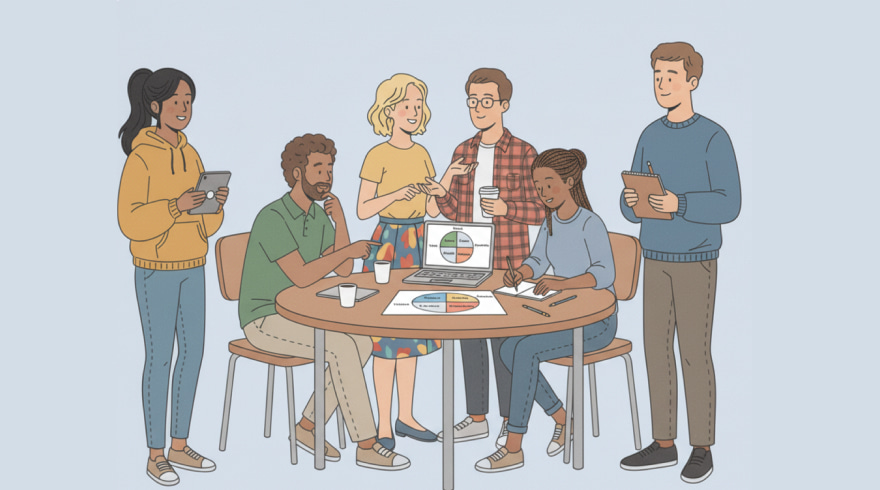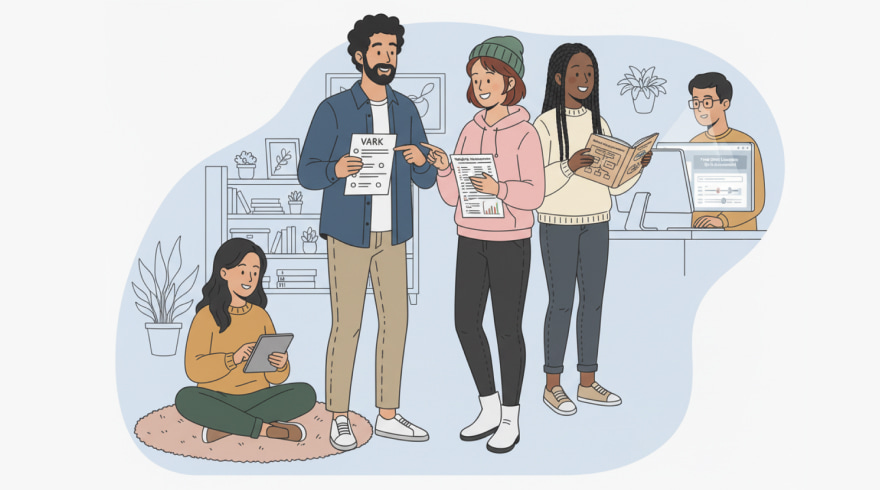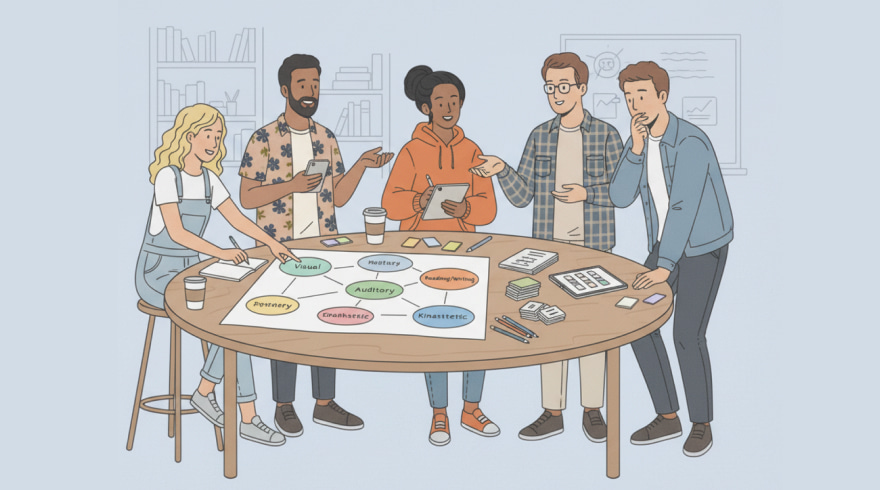A Complete Guide to the VARK Model and Personalized Learning Preferences
- 3 November 2025

What VARK Is and Why Learning Preferences Matter
The VARK framework classifies how individuals tend to absorb, process, and recall information across four modalities: Visual, Aural, Read/Write, and Kinesthetic. Instead of claiming people learn in only one way, the model highlights tendencies that shape study tactics, lesson design, and workplace training. When these tendencies are recognized, learners can select strategies that align with their strengths, and instructors can construct experiences that reduce friction and improve comprehension. This synergy helps learners move from passive exposure to active, deliberate practice.
Because classrooms, professional courses, and onboarding programs are increasingly multimodal, a succinct method for understanding learning preferences streamlines decision-making for both learners and facilitators. In practice, educators and trainers often begin by administering the VARK assessment to surface dominant and secondary modes. Rather than labeling people permanently, results act as a snapshot that sparks reflection, conversation, and experimentation. The real power emerges when learners iterate: they test note-making formats, refine rehearsal routines, and adjust environmental cues to build durable knowledge. Over time, these micro-adjustments compound into measurable performance gains and stronger confidence.
- Visual emphasizes diagrams, maps, charts, and spatial layouts.
- Aural (Auditory) focuses on lectures, discussion, and spoken explanations.
- Read/Write thrives on text, lists, glossaries, and structured notes.
- Kinesthetic favors labs, simulations, demos, and real-world practice.
How the Questionnaire Works and What Your Results Mean
The questionnaire presents everyday scenarios, asking how you would prefer to receive, review, or recall information in each situation. Responses are tallied across the four modalities, revealing a pattern that may point to one strong preference or a blend. A single preference suggests a primary route for input, while a multimodal profile indicates flexibility across contexts. Neither pattern is superior; the key is choosing the right strategy for the right task and switching methods as complexity or stakes rise.
Context matters, so it helps to interpret scores in light of goals, time constraints, and the type of material being learned. To support consistent interpretation and next steps, many schools deploy the VARK learning assessment alongside goal-setting to calibrate instruction. Results should prompt action: try color-coded mapping for a dense concept, record a quick voice recap after a study block, convert headings into bite-size notes, or rehearse with hands-on drills. Progress tracking then ties strategies to outcomes such as quiz accuracy, project quality, or skill fluency, helping learners iterate with intention.
- Use preference data to select study tools that fit the task at hand.
- Rotate modalities to strengthen retention under varied conditions.
- Document what works in a simple learning log to refine habits.
Benefits and Real-World Applications
Organizations across education, healthcare, and corporate training apply the model to streamline lesson design and boost engagement. Instructors map learning objectives to modality-rich activities, ensuring essential concepts are encountered through multiple channels. Learners, meanwhile, turn results into concrete study moves, like translating lecture notes into diagrams, converting readings into summaries, or rehearsing a workflow in a realistic simulation. When feedback loops are built in, people identify which combinations of methods and resources yield the sharpest understanding in the shortest time.
Because learning rarely happens in a vacuum, program designers align assessment data with capabilities, performance metrics, and learner autonomy. In curriculum planning, a clear, shared vocabulary accelerates collaboration among faculty, coaches, and instructional designers. As a result, many teams fold the VARK learning styles assessment into onboarding or module kickoffs to personalize pathways without overhauling entire courses. When matched with analytics from quizzes, peer reviews, and project deliverables, preference insights reveal practical, low-cost improvements that compound over a semester or training cycle.
| Modality | Best-Fit Activities | Quick Wins |
|---|---|---|
| Visual | Concept maps, infographics, timelines, annotated diagrams | Sketch relationships before reading dense passages |
| Aural | Seminars, podcasts, debates, peer teaching | Record a 2‑minute audio recap after each session |
| Read/Write | Structured notes, summaries, glossaries, checklists | Transform slides into concise bullet-point outlines |
| Kinesthetic | Labs, role-plays, prototypes, field observations | Run a short simulation to test a concept immediately |
- Blend modalities for capstone tasks that require flexible recall.
- Use peer feedback to validate which methods truly accelerate mastery.
- Align practice intensity with task difficulty to avoid cognitive overload.
Study Tactics and Teaching Strategies By Modality
Translating preferences into action starts with tangible, repeatable routines. Visual learners might convert chapters into layered mind maps, while auditory-oriented learners schedule short debriefs to talk through problem sets. Those who favor text can compress lectures into hierarchical notes and write summary questions at the end of each page. For kinesthetic needs, learners build mini-labs, manipulate objects, or rehearse steps physically to anchor memory through movement.
Educators can design agile lessons that toggle between demonstration, explanation, and student practice without losing cohesion. A well-sequenced workshop might begin with a diagram, shift to a discussion, offer a concise reading, and culminate in a hands-on exercise. In many program reviews, teams reference the VARK learning style assessment when deciding how to diversify activities across a unit. These deliberate rotations keep attention high and give every participant multiple entry points into complex ideas, all while reinforcing transfer to new settings.
- Visual: preview with a big-picture map before diving into details.
- Aural: schedule brief peer dialogues to refine understanding.
- Read/Write: revise notes using active verbs and precise headings.
- Kinesthetic: practice with real tools, real data, or realistic constraints.
Common Pitfalls, Myths, and Responsible Use
Misconceptions persist, including the belief that a single preference should dictate every learning activity or that preferences equal fixed ability. Overreliance on a single mode can create blind spots, reducing adaptability when demands shift. True expertise requires exposure across formats, especially as tasks increase in complexity and time pressure. The best practice is to treat preference data as a guide, not a gate, and to build a toolkit that works under varied conditions.
Labels can be helpful, but they should never limit access to challenging materials or substitute for evidence-based pedagogy. To avoid pigeonholing, facilitators can prioritize clarity, retrieval practice, feedback, and spaced repetition while still honoring preferences. In policy documents and program audits, teams may reference the VARK assessment of learning styles to standardize terminology, yet they pair it with outcome measures to ensure impact. This balanced stance protects learner agency, encourages experimentation, and keeps the focus on results rather than on static categories.
- Use preferences to choose starting strategies, not to exclude modalities.
- Cross-train by practicing with at least one non-preferred method weekly.
- Measure progress using objective indicators tied to real tasks.
FAQ: Practical Answers About VARK
How long does the questionnaire take?
Most people complete it in under fifteen minutes. The time can vary based on how thoughtfully you consider each scenario, but it’s designed to be concise and accessible. Many learners finish during a single class period or before a study session, then immediately apply insights to planning and note-making.
Does a result mean I should only study in one way?
No, a result highlights preferences, not strict rules. It’s smart to start with your favored mode, then add complementary strategies to broaden retention and transfer. Flexibility improves resilience when materials, instructors, or environments change, and it helps you perform under pressure.
Can my preferences change over time?
Yes, preferences can shift with experience, domain knowledge, and task demands. As you gain expertise, you may find that blended approaches outperform any single method. Revisit your strategies periodically and track outcomes to see what genuinely moves the needle for you.
How should teachers apply the insights?
Instructors can diversify delivery without diluting rigor by sequencing activities that touch multiple modalities. Clear objectives, retrieval practice, and timely feedback remain core, while modality choices boost engagement and access. Small changes, like adding a diagram, a brief discussion, or a hands-on demo, often yield outsized benefits.
What if my profile is evenly split?
A balanced profile signals versatility. Choose methods that best match the content and constraints, and rotate techniques for complex tasks. When in doubt, run short trials: compare outcomes after different study routines and keep the one that consistently improves accuracy, speed, or confidence.
Latest News
-
![Understanding and Using Multiple Intelligences: A Complete Assessment Guide]() Understanding and Using Multiple Intelligences: A Complete Assessment Guide Take Learning Style Assessment Online Get Started Foundations of Multiple Intelligences Test Human capability is a mosaic, not a single metric, and this insight sits at the heart of the multiple intelligences perspective. Instead of ranking people on a narrow academic scal...
Understanding and Using Multiple Intelligences: A Complete Assessment Guide Take Learning Style Assessment Online Get Started Foundations of Multiple Intelligences Test Human capability is a mosaic, not a single metric, and this insight sits at the heart of the multiple intelligences perspective. Instead of ranking people on a narrow academic scal... - 31 October, 2025
-
![The Complete Guide to Understanding and Using Learning Style Assessments]() The Complete Guide to Understanding and Using Learning Style Assessments Take Learning Style Assessment Online Get Started Why Understanding Your Learning Style Matters Most people study harder when they could study smarter, and that difference often stems from knowing how the brain prefers to take in, transform, and remember information. A tho...
The Complete Guide to Understanding and Using Learning Style Assessments Take Learning Style Assessment Online Get Started Why Understanding Your Learning Style Matters Most people study harder when they could study smarter, and that difference often stems from knowing how the brain prefers to take in, transform, and remember information. A tho... - 30 October, 2025
-
![The Guide to Personalized Learning Preferences and Reflective Evaluation]() The Guide to Personalized Learning Preferences and Reflective Evaluation Take Learning Style Assessment Online Get Started Why Personalizing How You Learn Changes Results Most people study harder when they feel progress is within reach, yet effort alone doesn’t guarantee improvement. The real unlock is making your study tactics fit the wa...
The Guide to Personalized Learning Preferences and Reflective Evaluation Take Learning Style Assessment Online Get Started Why Personalizing How You Learn Changes Results Most people study harder when they feel progress is within reach, yet effort alone doesn’t guarantee improvement. The real unlock is making your study tactics fit the wa... - 29 October, 2025



